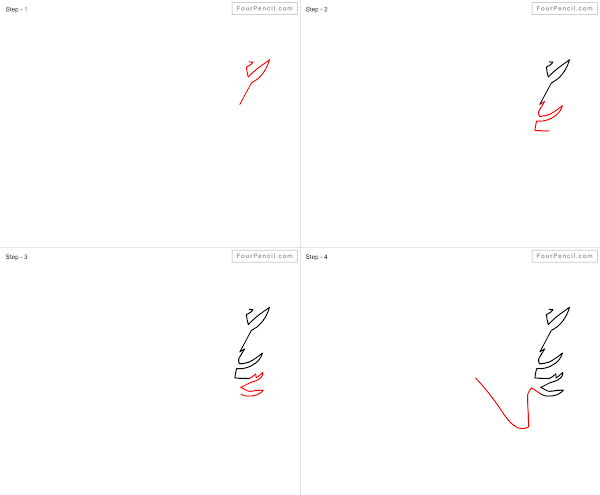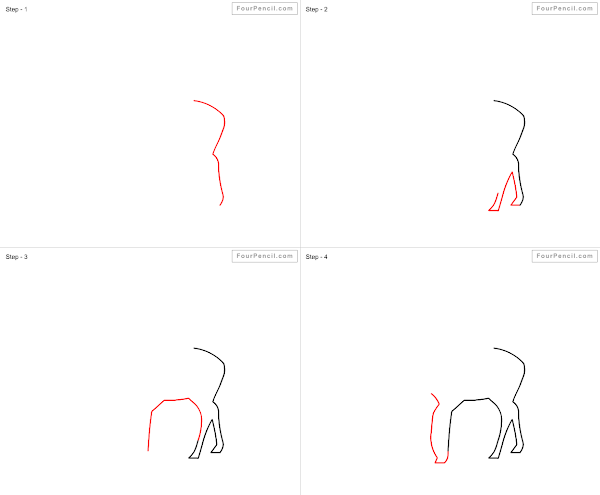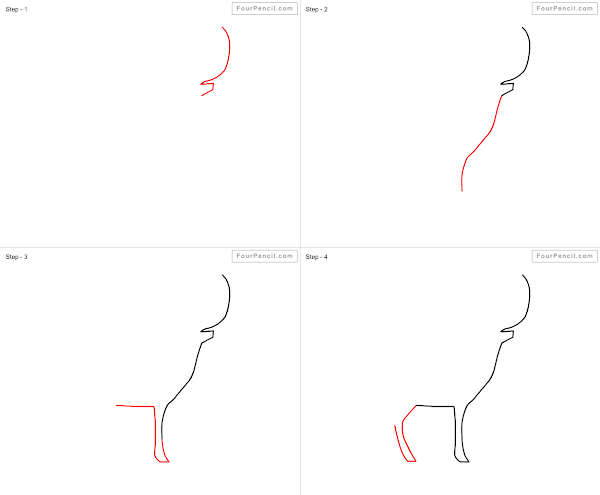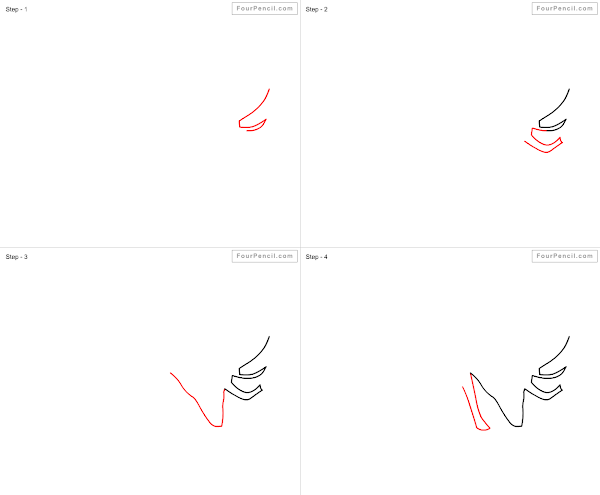How To Draw A Deer Head Step By Step
How to draw Deer for kids - pace by step - Fact - Deer (atypical and plural) are the ruminant mammals forming the family Cervidae. Species in the family unit include the white-tailed deer, mule deer (such as the black-tailed deer), elk, moose, red deer, reindeer (caribou), fallow deer, roe deer, pudú and chital.  How to draw Deer for kids - stride past step - Fact - Male deer of all species (except the Chinese h2o deer) and female reindeer grow and shed new antlers each yr. In this they differ from permanently horned animals, such every bit antelope, which are in the same order as deer and may carry a superficial resemblance to them.
How to draw Deer for kids - stride past step - Fact - Male deer of all species (except the Chinese h2o deer) and female reindeer grow and shed new antlers each yr. In this they differ from permanently horned animals, such every bit antelope, which are in the same order as deer and may carry a superficial resemblance to them.  How to depict Deer for kids - footstep by step - Fact - The musk deer of Asia and h2o chevrotain (or mouse deer) of tropical African and Asian forests are not unremarkably regarded as true deer and form their ain families: Moschidae and Tragulidae, respectively.
How to depict Deer for kids - footstep by step - Fact - The musk deer of Asia and h2o chevrotain (or mouse deer) of tropical African and Asian forests are not unremarkably regarded as true deer and form their ain families: Moschidae and Tragulidae, respectively.  How to draw Deer for kids - step past step - Fact - Deer live in a variety of biomes, ranging from tundra to the tropical rainforest. While often associated with forests, many deer are ecotone species that live in transitional areas between forests and thickets (for comprehend) and prairie and savanna (open space).
How to draw Deer for kids - step past step - Fact - Deer live in a variety of biomes, ranging from tundra to the tropical rainforest. While often associated with forests, many deer are ecotone species that live in transitional areas between forests and thickets (for comprehend) and prairie and savanna (open space).  How to draw Deer for kids - stride past footstep - Fact - The majority of large deer species inhabit temperate mixed deciduous forest, mountain mixed coniferous forest, tropical seasonal/dry wood, and savanna habitats around the world.
How to draw Deer for kids - stride past footstep - Fact - The majority of large deer species inhabit temperate mixed deciduous forest, mountain mixed coniferous forest, tropical seasonal/dry wood, and savanna habitats around the world.  How to draw Deer for kids - step by step - Fact - Clearing open areas inside forests to some extent may actually benefit deer populations by exposing the understory and allowing the types of grasses, weeds, and herbs to grow that deer like to consume.
How to draw Deer for kids - step by step - Fact - Clearing open areas inside forests to some extent may actually benefit deer populations by exposing the understory and allowing the types of grasses, weeds, and herbs to grow that deer like to consume.  How to draw Deer for kids - step past stride - Fact - Additionally, access to next croplands may also benefit deer. However, adequate wood or castor comprehend must however be provided for populations to grow and thrive.
How to draw Deer for kids - step past stride - Fact - Additionally, access to next croplands may also benefit deer. However, adequate wood or castor comprehend must however be provided for populations to grow and thrive.  How to depict Deer for kids - step past step - Fact - Deer are widely distributed, with indigenous representatives in all continents except Antarctica and Australia, though Africa has only one native deer, the Barbary stag, a subspecies of red deer that is confined to the Atlas Mountains in the northwest of the continent.
How to depict Deer for kids - step past step - Fact - Deer are widely distributed, with indigenous representatives in all continents except Antarctica and Australia, though Africa has only one native deer, the Barbary stag, a subspecies of red deer that is confined to the Atlas Mountains in the northwest of the continent.  How to draw Deer easy - step past step - Fact - However, dormant deer take been introduced to S Africa. Small species of brocket deer and pudús of Fundamental and South America, and muntjacs of Asia by and large occupy dumbo forests and are less oftentimes seen in open spaces, with the possible exception of the Indian muntjac.
How to draw Deer easy - step past step - Fact - However, dormant deer take been introduced to S Africa. Small species of brocket deer and pudús of Fundamental and South America, and muntjacs of Asia by and large occupy dumbo forests and are less oftentimes seen in open spaces, with the possible exception of the Indian muntjac.  How to draw Deer easy - footstep past stride - Fact - There are as well several species of deer that are highly specialized, and alive almost exclusively in mountains, grasslands, swamps, and "moisture" savannas, or riparian corridors surrounded by deserts. Some deer have a circumpolar distribution in both Northward America and Eurasia.
How to draw Deer easy - footstep past stride - Fact - There are as well several species of deer that are highly specialized, and alive almost exclusively in mountains, grasslands, swamps, and "moisture" savannas, or riparian corridors surrounded by deserts. Some deer have a circumpolar distribution in both Northward America and Eurasia.  How to draw Deer for Beginners - Fact - Examples include the caribou that live in Arctic tundra and taiga (boreal forests) and moose that inhabit taiga and adjacent areas. Huemul deer (taruca and Chilean huemul) of Southward America'southward Andes fill the ecological niches of the ibex and wild caprine animal, with the fawns behaving more than similar goat kids.
How to draw Deer for Beginners - Fact - Examples include the caribou that live in Arctic tundra and taiga (boreal forests) and moose that inhabit taiga and adjacent areas. Huemul deer (taruca and Chilean huemul) of Southward America'southward Andes fill the ecological niches of the ibex and wild caprine animal, with the fawns behaving more than similar goat kids.  How to draw Deer for Beginners - Fact - The highest concentration of large deer species in temperate North America lies in the Canadian Rocky Mountain and Columbia Mountain regions between Alberta and British Columbia where all v North American deer species (white-tailed deer, mule deer, caribou, elk, and moose) can be found.
How to draw Deer for Beginners - Fact - The highest concentration of large deer species in temperate North America lies in the Canadian Rocky Mountain and Columbia Mountain regions between Alberta and British Columbia where all v North American deer species (white-tailed deer, mule deer, caribou, elk, and moose) can be found.  How to draw Deer for Children - Fact - This region has several clusters of national parks including Mount Revelstoke National Park, Glacier National Park (Canada), Yoho National Park, and Kootenay National Park on the British Columbia side, and Banff National Park, Jasper National Park, and Glacier National Park (U.Due south.) on the Alberta and Montana sides.
How to draw Deer for Children - Fact - This region has several clusters of national parks including Mount Revelstoke National Park, Glacier National Park (Canada), Yoho National Park, and Kootenay National Park on the British Columbia side, and Banff National Park, Jasper National Park, and Glacier National Park (U.Due south.) on the Alberta and Montana sides.  How to draw Deer for Children - Fact - Mountain slope habitats vary from moist coniferous/mixed forested habitats to dry subalpine/pine forests with tall meadows higher up. The foothills and river valleys between the mount ranges provide a mosaic of cropland and deciduous parklands.
How to draw Deer for Children - Fact - Mountain slope habitats vary from moist coniferous/mixed forested habitats to dry subalpine/pine forests with tall meadows higher up. The foothills and river valleys between the mount ranges provide a mosaic of cropland and deciduous parklands.  How to draw Deer for Preschoolers - Fact - The rare woodland caribou take the most restricted range living at higher altitudes in the subalpine meadows and alpine tundra areas of some of the mountain ranges. Elk and mule deer both migrate between the alpine meadows and lower coniferous forests and tend to be most common in this region.
How to draw Deer for Preschoolers - Fact - The rare woodland caribou take the most restricted range living at higher altitudes in the subalpine meadows and alpine tundra areas of some of the mountain ranges. Elk and mule deer both migrate between the alpine meadows and lower coniferous forests and tend to be most common in this region.  How to draw Deer for Preschoolers - Fact - Elk also inhabit river valley bottomlands, which they share with White-tailed deer. The White-tailed deer have recently expanded their range within the foothills and river valley bottoms of the Canadian Rockies owing to conversion of land to cropland and the clearing of coniferous forests allowing more deciduous vegetation to grow up the mountain slopes.
How to draw Deer for Preschoolers - Fact - Elk also inhabit river valley bottomlands, which they share with White-tailed deer. The White-tailed deer have recently expanded their range within the foothills and river valley bottoms of the Canadian Rockies owing to conversion of land to cropland and the clearing of coniferous forests allowing more deciduous vegetation to grow up the mountain slopes.  They also live in the aspen parklands north of Calgary and Edmonton, where they share habitat with the moose. The adjacent Great Plains grassland habitats are left to herds of elk, American bison, and pronghorn antelope.
They also live in the aspen parklands north of Calgary and Edmonton, where they share habitat with the moose. The adjacent Great Plains grassland habitats are left to herds of elk, American bison, and pronghorn antelope. 

Source: http://fp-how-to-draw.blogspot.com/2015/07/how-to-draw-deer-for-kids-step-by-step.html
Posted by: mitchelltheinder1941.blogspot.com


0 Response to "How To Draw A Deer Head Step By Step"
Post a Comment